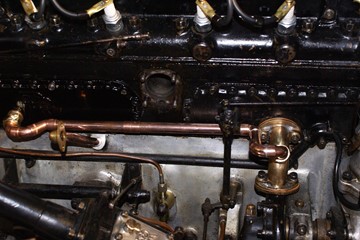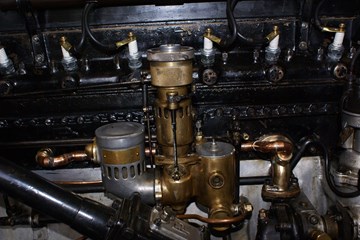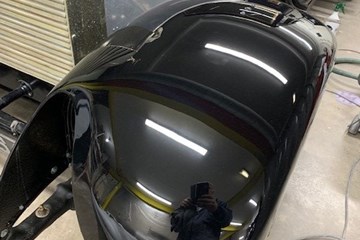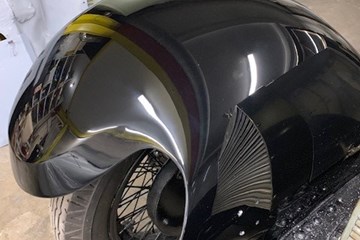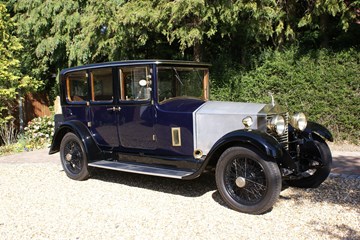GYK91 update, Windovers 4 door Sports Saloon
Windovers 4 door Sports Saloon
In the July 2019 edition of S & S Issue 355 I described how and why I’d decided to purchase a 20hp after 30 plus years of 1950’s Jaguar Sports Car ownership whilst still retaining my Jaguar collection. The article predominantly described the re-wiring of the car and the horror of the state of the wiring removed from the conduits. The state of the wiring is also reported in Resources and Articles on this web site. Since then I note that a number of 20hp and 20/25 owners have now tackled this job and found the same problems looming in the original wiring loom.
I concluded by reporting on the next jobs planned for the car, these have now been completed I’d like to share with you the work that has been done.
As soon as the wiring loom was replaced the car was trailered up to Heritage Classics in Middlesbrough to rectify the misshapened nearside front wing. According to papers with the car it was involved in an altercation with another motor vehicle when in America over 40 years ago. Although the repair looked reasonable the profile of the wing didn’t match the offside one at all. However once the wing was off the car and stripped it soon became obvious how poor the repair was. Odd bits of aluminium were welded in together with fibre glass repairs covered up with underseal, it was at this point it was decided to take the offside wing off as well to ensure both were suitably repaired. Like all jobs they grow, the offside wing whilst better than the nearside required much needed repair as well. At that stage “in for a penny in for a pound” it was decided to get the job done properly and the back wings, running boards and skirts were all removed from the car. John Collins of Heritage Classics has done quite a remarkable job stripping and repairing all four wings, getting their profiles with the tyres right, repairing the tool box lid hinges and repainting it all in Masons Black. I have to say it now all looks terrific.
Eventually after many months the car returned home whereupon my attention could turn to the mechanicals. The previous owner had kept a very comprehensive service book of all the work he had done on the car over the previous 12 or so years, but the car during that time had done relatively few miles. I wanted to use the car for touring and therefore wanted to establish a degree of reliability so decided to undertake a full and comprehensive service on the car. I also had been studying the modifications that regular users had undertaken especially those who were regular participants on the 20hp tours and rallies. One of the early problems that I encountered was the swift rise in engine temperature when the car came to a halt at junctions or roundabouts albeit returning to normal running temperature once moving away again. This required some understanding which I shall explain later.
I was introduced to a motor engineer who lives quite near to home and whose family have owned a 20hp for over 65 years, we discussed what I wanted to do and he was keen to help or should I say do the work and I’d help and learn. During the winter of 2019/2020 one evening a week we tackled the work programme, it started with me doing all the oiling. We then moved on to removing the brake drums to check bearings and linings, all of which was found to be in order. All oils were changed but the gearbox and back axle oil looked as if it had never been out for 40 years. After about 35 miles whilst still hot the new oils were drained again and refilled. I am planning doing this one more time after another 100 or so miles. The tappet settings were adjusted as needed.
The modifications I wanted to make were the installation of a remote oil cleaner kit and an Alan Murcott thermostat kit both of which are used by many regular tour participants. The oil cleaner kit was obtained from Ristes and fitted perfectly with good instructions. The thermostat kit is now available from Tim Payne Overdrives who has bought the design and some unsold kits with a plan to manufacture them himself. My kit was an original of Alan Murcott one and I have to say it is a beautiful piece of engineering with quite extensive but easy to follow instruction sheets. To install the thermostat kit necessitates the draining and removal of the radiator which is no mean task and requires two persons to do the job. By removing the radiator you can get at the front of the engine easily and apply the leverage that is needed to remove the old screws holding the front cover plate which has to be replaced with the new thermostat housing.
Turning to the problem of swift increase in engine temperature when stopped at junctions I consulted a number of eminent sources of technical expertise but also read the various articles in the 20hp Newsletter on the Register web site to understand the cause. In simplistic terms the water pump is at the front offside of the engine and the return pipe to the radiator is also at the front of the engine whereas the temperature gauge is at the rear of the engine block. When the engine speed is reduced to tick over whilst stationary this causes the water to circulate around the front of the engine only and at the rear the temperature rises, this apparently is a common problem with 20hp's. Rolls Royce must have recognised this problem as the 20/25 cylinder head has six water holes blanked off to aid water flow to the rear of the engine, the service records with my car showed this to have been done. This problem is also compounded by the accumulation of sludge in the engine block.
Many of the cars I’ve looked at have had a rubber hose connected to the water pump inlet elbow and the rear engine plate to aid flow to the rear of the engine. The owners were very satisfied with the solution but I wanted to find a better way of delivering water flow to the rear of the engine. I came across one car from the North East at the 2019 Annual Rally where the pipe was a copper one taking the shortest route behind the carburettor, it was this solution that I decided to follow. First of all it needs some of the carburettor control rods being removed as well as the carburettors themselves, this then allows access to the rear plate screws enabling the plate itself to be removed. Once the rear plate is off you can assess the amount of sludge that needs to be removed. To do this I used a good jet of water but not a high pressure jet. If you do this make sure you blank off the carburettor breather pipe hole otherwise you will get water in the oil. You can gain access to part of the front of the engine but not as easily as for the back without removing the front plate which I didn’t do as it entails a lot of extra dismantling. Looking inside the rear of the engine it became obvious that some of the waterways were not as free as they should have been especially between the cylinder liners and head studs. To alleviate this I used a hacksaw blade with the edges filed off to saw through the cavity and open up the waterways. There is a very difficult to see head stud across the middle of the rear of the engine which was blocked solid. When this work was completed it was time to work out the route of the copper pipe which I wanted to go behind the carburettor as there was sufficient space. Careful measuring and planning to ensure that the control rods when re-installed weren’t fouled allowed a discreet pipe to be designed and assembled by a plumber friend. The pipe tapped into the pump elbow and into the rear engine plate. After everything was carefully put back in place and the radiator filled with a mixture of anti-freeze it was time to start the engine and to see that everything worked as planned. Once a couple of slight leaks were attended to we took the engine up to working temperature, the copper feed pipe to the rear of the engine obviously working as planned warming up nicely.
Looking at the copper pipe it looks as if it has always been there!! I know these modifications may not be to everyone’s liking especially the purists but they are practical without unduly altering the look and feel of the car.
Since all this winter work and before lockdown I did two test runs each of over 40 miles and found everything working as planned, the engine temperature ran at about 85 degrees and stayed there when stationary.
All of this work was towards having a reliable car capable of going on 20hp Register tours. We booked the 2020 Annual Rally which was going to be our first long test of nearly 300 miles round trip we also booked the 2021 Loire 8 day Rally but these plans have now all had to be changed due to CV-19. At the moment I am just itching to get out in the car to put some miles on it to establish a proven reliable car.
Alan Harris
16.04.20

